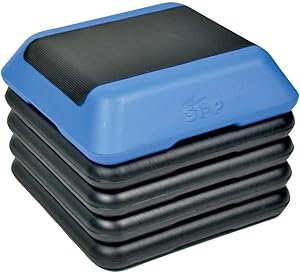Are you tired of feeling sluggish at your desk? We’ve all been there!
But did you know that simple stretches and exercises can boost your productivity and energy levels?
This article will introduce you to 10 easy-to-do desk exercises designed to revitalize your body and mind while you work.
It’s no secret that sitting for long periods can take a toll on your health and productivity. But the good news is that even small movements can make a big difference.
By incorporating these quick and effective exercises into your workday, you’ll not only feel better but also find yourself more focused and energized.
These exercises are scientifically proven to increase blood flow to the brain, improve flexibility, reduce stress, and boost overall well-being. So, get ready to ditch the desk slump and unleash your inner productivity powerhouse!
The Power of Movement

Why Sitting Still is the Enemy
We all know the feeling of sluggish, afternoon slump that makes it hard to focus on work.
But what if I told you that the culprit might be your chair? Prolonged sitting, a modern-day epidemic, can have a detrimental impact on your body, energy, and focus.
Sitting for extended periods, without regular movement, can lead to a host of problems. The most common is back pain, caused by the strain on muscles and ligaments that occurs when the spine is in a fixed position.
Poor posture, another byproduct of prolonged sitting, can lead to muscle imbalances and chronic pain.
Reduced circulation due to inactivity further compounds the issue, slowing down blood flow to the brain and impacting cognitive function.
This lack of movement translates into a decrease in energy, making it harder to stay alert and focused throughout the day.
Your productivity plummets, and you feel drained and sluggish, leading to frustration and a sense of being stuck in a rut. It’s a vicious cycle that can negatively impact your overall well-being.
The Science of Stretching
The good news is that even small changes can make a big difference. Stretching, in particular, is a simple yet powerful way to combat the negative effects of prolonged sitting.
Regular stretching increases muscle flexibility, improves blood circulation, and reduces muscle tension.
This helps prevent the strain caused by spending hours in a chair, minimizing stiffness and soreness. Stretching also plays a crucial role in maintaining good posture, which is essential for preventing back pain, neck pain, and other musculoskeletal issues.
Beyond physical benefits, stretching promotes mental and emotional well-being. It helps release tension, reduce stress, and boost mood, leaving you feeling more energized and refreshed.
A few minutes of stretching throughout your workday can be a game-changer for your overall health and productivity.
Movement & Mental Clarity
While stretching is fantastic for improving flexibility and circulation, incorporating movement into your routine goes even further by boosting your cognitive function.
Regular movement breaks increase blood flow to the brain, delivering oxygen and nutrients that fuel brainpower.
This leads to enhanced focus, creativity, and mental clarity. Movement also helps clear mental fog and improve problem-solving skills, making you better equipped to tackle challenging tasks and make sound decisions.
Stepping away from your desk for a short walk, taking a few minutes to do some light exercises, or even just stretching can provide a mental refresh, making you feel energized and ready to tackle any task with renewed vigor. It’s a simple yet effective way to improve your productivity and make your workday more enjoyable and fulfilling.
Boosting Productivity with Desk Exercises

Ready to ditch the afternoon slump and unlock peak productivity? It’s time to move!
You don’t need a gym membership or fancy equipment to reap the benefits of exercise. Even a few minutes of movement throughout the day can make a world of difference.
Here’s a quick and easy guide to 10 desk exercises that will improve your posture, energy levels, and overall productivity:
Warm-Up: Get Those Muscles Moving
Step-by-Step:
- Arm Circles: Stand up and extend your arms out to your sides. Gently rotate your arms forward in a circular motion for 10-15 repetitions. Repeat in the opposite direction.
- Neck Rolls: Slowly tilt your head to the right, then to the left, keeping your shoulders relaxed. Circle your head clockwise for 5 repetitions, then counterclockwise.
- Shoulder Shrugs: Raise your shoulders up towards your ears, hold for a few seconds, then release. Repeat for 10-15 repetitions.
Benefits: Warming up your muscles with simple stretches prepares your body for the exercises to come and can help prevent injuries.
Tips: Remember to breathe deeply throughout each stretch and relax your shoulders to avoid tension.
Exercise 1: The Desk Push-Up
Step-by-Step:
- Modified Push-Ups: For beginners, start with wall push-ups. Stand facing a wall, about an arm’s length away. Lean forward with your hands at shoulder-width apart on the wall and lower your chest toward the wall, bending your elbows. Push back to the starting position.
- Desk Push-Ups: As you gain strength, try desk push-ups. Place your hands shoulder-width apart on the edge of your desk, fingers pointing forward. Lower your chest towards the desk, keeping your body in a straight line from your head to your feet. Push back up to the starting position.
- Advanced Push-Ups: For a greater challenge, try push-ups on the floor.
Benefits: Desk push-ups are great for strengthening your chest, shoulders, and triceps while improving posture and core stability.
Tips: Focus on keeping your body in a straight line and engaging your core muscles for maximum benefit.
Exercise 2: Chair Squats
Step-by-Step:
- Stand with your feet hip-width apart, facing forward.
- Lower yourself as if you were about to sit in a chair, keeping your back straight.
- Stop when your thighs are parallel to the floor.
- Push back up to the starting position.
Benefits: Chair squats strengthen your legs, improve core stability, and can help increase your metabolism, boosting energy levels.
Tips: Ensure your back remains straight and your knees don’t go over your toes. Start with a few repetitions and gradually increase as you get stronger.
Exercise 3: Calf Raises
Step-by-Step:
- Stand with your feet hip-width apart, holding onto your desk or chair for balance.
- Rise up onto your toes, keeping your heels off the ground.
- Slowly lower your heels back down to the ground.
Benefits: Calf raises strengthen your calves, improve ankle mobility, and boost circulation, helping reduce fatigue in your legs.
Tips: Focus on squeezing your calf muscles at the top of each raise. You can increase the intensity by holding onto your desk for support and lifting one leg off the ground.
Exercise 4: Wall Sit
Step-by-Step:
- Stand with your back against a wall, feet shoulder-width apart.
- Slowly slide down the wall until your knees are bent at a 90-degree angle and your thighs are parallel to the floor.
- Hold this position for as long as you can, engaging your quadriceps.
Benefits: Wall sits are an isometric exercise that targets your quadriceps and helps improve core strength and stability.
Tips: Make sure your back stays flat against the wall, and your knees stay aligned with your toes. Start with 30-second holds and gradually increase the time as you build endurance.
Exercise 5: Desk Plank

Step-by-Step:
- Position yourself face down on the floor, with forearms on the floor shoulder-width apart.
- Engage your core muscles and lift your body off the floor, forming a straight line from your head to your heels.
- Hold this position for as long as you can, focusing on keeping your core engaged and your body stable.
Benefits: Desk planks strengthen your core, improve posture, and help improve balance and stability.
Tips: Keep your core engaged throughout the exercise. Start with 30-second holds and gradually increase the time as you build endurance. If you’re new to planks, you can start with a modified plank on your knees.
Exercise 6: Wrist Stretches
Step-by-Step:
- Extend one arm in front of you with your palm facing up.
- Use your other hand to gently bend your wrist down toward the floor, stretching the top of your forearm.
- Hold for 30 seconds, then repeat on the other side.
Benefits: Wrist stretches help to relieve tension from long typing sessions, reducing the risk of carpal tunnel syndrome.
Tips: Focus on stretching slowly and gently, avoiding any sharp movements that could cause injury.
Exercise 7: Neck Rotations
Step-by-Step:
- Sit up straight with your shoulders relaxed.
- Slowly rotate your head to the right, then to the left.
- Repeat this movement 10 times in each direction.
Benefits: Neck rotations relieve tension, increase flexibility in the neck and shoulders, and improve blood flow to the head.
Tips: Focus on slow, controlled movements and avoid forcing your neck to rotate further than is comfortable.
Exercise 8: Shoulder Rolls

Step-by-Step:
- Sit up straight, with your shoulders relaxed.
- Roll your shoulders forward in a circular motion, as if you were drawing a circle with your shoulders.
- Repeat this movement 10 times, then repeat in the opposite direction.
Benefits: Shoulder rolls relieve shoulder tension, improve posture, and help prevent pain and stiffness.
Tips: Focus on rolling your shoulders slowly and smoothly, maintaining a relaxed posture.
Exercise 9: Seated Twists
Step-by-Step:
- Sit up straight with your feet flat on the floor.
- Place your hands on your thighs.
- Twist your upper body to the right, keeping your back straight and engaging your core muscles.
- Return to the starting position and repeat on the other side.
Benefits: Seated twists strengthen your core, improve flexibility in the spine and help relieve tension in your back and shoulders.
Tips: Focus on maintaining a straight back and engaging your core muscles throughout the exercise.
Exercise 10: The Desk Yoga Flow

Step-by-Step:
- Cat-Cow Pose: Start in a tabletop position with your hands shoulder-width apart and knees hip-width apart. Inhale and arch your back like a cat, tucking your chin to your chest. Exhale and round your back, dropping your belly towards the floor, like a cow. Repeat 5-10 times.
- Shoulder Stretch: Extend your arms out to your sides, shoulder height. Interlock your fingers and turn your palms away from you. Gently push your arms back as you tilt your head forward. Hold for 15-20 seconds.
- Child’s Pose: From a tabletop position, bring your hips back to your heels and rest your forehead on the floor. Hold for 30 seconds, allowing your spine to lengthen.
Benefits: This desk yoga flow helps increase relaxation, improve flexibility and posture, and reduce stress.
Tips: Focus on your breath and move slowly and smoothly through each pose.
Remember: Consistency is key! Aim to incorporate these exercises into your daily routine. Even a few minutes of movement throughout the day can help you feel more energized, focused, and productive.
Tracking Your Progress: Celebrate Small Wins
Tracking your progress is a great way to stay motivated and see how far you’ve come. Here’s how you can measure your success:
- Set Milestones: Set small, achievable goals, like completing your desk exercises every day for a week. Celebrate these victories to keep your momentum going.
- Use a Journal or App: Write down your exercises or use a fitness app to track your daily movements. This will help you stay accountable and remind you to stick with it.
- Notice Physical Changes: Pay attention to how you feel after a week or two of regular exercise. You might notice less back pain, improved energy, or even better posture!
Creating Reminders: Don’t Forget to Move

Sometimes, life gets busy, and it’s easy to forget about your desk exercises. Here’s how to remind yourself:
- Set Alarms or Timers: Set a reminder on your phone or computer to prompt you to move every hour. A simple timer can go a long way in keeping you on track.
- Post Visual Cues: Keep a sticky note on your desk or a sign near your workspace that reminds you to take a break and move. Visual reminders can be effective in encouraging you to stay consistent.
Get Support: Make It a Group Effort
You don’t have to do this alone! Involving your coworkers or family members can make desk exercises more fun and help everyone stay on track. Here’s how:
- Join a Challenge: Team up with your colleagues or friends and start a desk exercise challenge. Compete on who can do the most steps or who can stay consistent for the longest.
- Create Accountability Buddies: Find a work buddy who’s also interested in making desk exercises a habit. You can remind each other and celebrate your progress together.
Keep It Fun: Mix Things Up
Variety is the spice of life, so keep things fresh and exciting:
- Try New Exercises: Don’t be afraid to mix up your routine. Add new exercises or change the order of your movements to keep it interesting.
- Incorporate Music: Play some upbeat music while doing your exercises. This can help boost your mood and make the activity more enjoyable.
Making Desk Exercises Part of Your Daily Routine
The key to making desk exercises a habit is to integrate them into your daily life in a way that feels effortless.
Start small, stay consistent, and track your progress. Over time, these simple exercises will become a natural part of your workday, helping you feel more energized, focused, and productive. So, let’s get moving!
Finding the Right Time: When to Get Moving

Listen to your body and your workflow. You’ll find certain times are better suited for movement than others:
- Natural Breaks: If you’ve been sitting for a while, your body is likely to be stiff. Take advantage of natural breaks in your workflow to get up and stretch.
- After Lunch: Your energy levels tend to dip after a meal. A quick set of desk exercises can help you feel refreshed and boost your productivity for the afternoon.
- Mid-Morning: If you find yourself slumping in the mid-morning, a few minutes of movement can re-energize you and help you stay focused.
Staying Motivated: Keeping the Momentum Going
Motivation ebbs and flows. Here are some strategies to make desk exercises a lasting habit:
- Set Reminders: Use your phone’s calendar or a to-do list app to set reminders for your desk exercises. This will help you stay on track, even on busy days.
- Work Out with a Friend or Colleague: Having a workout buddy can make it more fun and help you stay accountable.
- Track Your Progress: Use a fitness tracker or a simple notebook to track your progress. Seeing how much you’re accomplishing can be motivating.
- Celebrate Your Wins: Don’t underestimate the power of small victories! Reward yourself for sticking to your routine.
Remember, building healthy habits is a journey, not a race. Be patient with yourself and focus on making gradual changes that work for you.
You’ll be surprised at how much better you feel, both physically and mentally, when you prioritize movement throughout your workday.

FAQs About Desk Exercises
Q: What if I don’t have time?
Don’t worry, you don’t need hours to reap the benefits of desk exercises! Even a few minutes of movement can make a big difference. Try incorporating short bursts of movement into your workday, like 5 minutes during your lunch break or a quick set of squats while waiting for a document to download. Consistency is key, and even small amounts of movement can boost your energy and focus.
Q: Are these exercises safe for everyone?
While these exercises are generally safe, it’s always best to listen to your body. Start slowly and gradually increase the intensity. If you have any pre-existing conditions or concerns, consult your doctor or a qualified healthcare professional before starting any new exercise program. They can tailor a safe and effective routine for your individual needs.
Q: How do I know if I’m doing them correctly?
Proper form is essential for maximizing the benefits and preventing injuries. You can find helpful resources online, including video tutorials, to demonstrate the correct techniques. Remember, it’s better to start slowly and focus on proper form than to rush through the exercises. If you need further guidance, consider consulting with a certified personal trainer or fitness professional.
Q: Can I do these exercises while on conference calls?
Absolutely! Many of these exercises can be done discreetly while sitting or standing, even during virtual meetings. Think about incorporating simple stretches, arm circles, or leg lifts while you listen. Staying active helps you focus and reduces the fatigue that can come with prolonged sitting, making you more productive overall.
Boost your productivity with desk exercises, perfect for integrating into Home Office Setup Ideas 2025.
Get Moving, Get More Done, Get Happy!
So, you’ve learned about the benefits of incorporating simple desk exercises into your daily routine. These moves aren’t just about feeling good, they’re about boosting your productivity, improving your overall health, and reducing stress.
By taking short breaks to stretch, move, and engage your body, you can experience a surge of energy, sharpen your focus, and feel better overall.
Ready to start feeling the difference? Begin today by integrating these desk exercises into your workday. Set reminders, schedule short movement breaks, and encourage your colleagues to join in.
You’ll be surprised at how even a few minutes of movement can make a big impact on your energy, concentration, and mood.
Remember, a healthy body leads to a healthy mind. Take charge of your productivity and your health. Get moving, get more done, and get happy!















